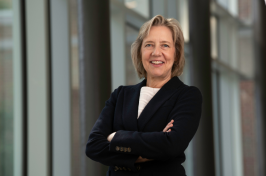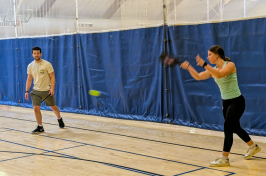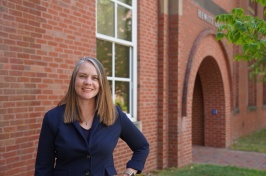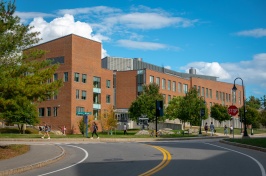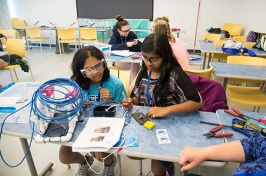H.S. Students in UNH Project SMART to Launch ""Satellite"" July 18
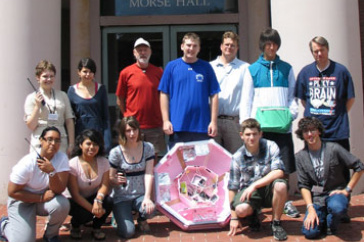
From left to right, kneeling: Mariel Cabrera- Lawrence, MA Lawrence High School; Julia Heredia- Hayward, CA San Lorenzo High School; Meghan Fisher- Newmarket, NH Newmarket Junior-Senior High School; Bradley Olsen- Dover, NH Dover High School; Adam White- Amherst, NH Academy for Science and Design. Standing: Danielle Jacques- Pembroke, NH Pembroke Academy; Isabella Pagano- Bethesda, MD Sidwell Friends School; Rich Messeder, UNH; Eric Gutermann- Somersworth, NH Somersworth High School; Scott Goelzer; Dimitrios Tsaras- Tagarades, Greece Music School of Thessaloniki; Lou Broad. In the center of the mock satellite/flight frame is the payload instrument bay, which contains radios, video cameras, and data collection instruments consisting of a GPS receiver, Geiger counter, and temperature sensors. Photo by David Sims, UNH-EOS.
DURHAM, N.H. -- A handful of high school students hope to make history of a sort next Monday (July 18, 2011) when a cardboard and Styrofoam vehicle they built glides back to Earth following a 90-minute balloon ride up to the edge of outer space to gather data on cosmic rays. The launch will occur at 9 a.m. from the Vermont Agricultural Business Education Center in Brattleboro.
The dish-shaped one-of-a-kind reentry vehicle - one meter in diameter and weighing under two kilograms, the Federal Aviation Administration limit - will carry a payload of a miniscule Geiger counter, two temperature sensors, and two video cameras about the size of a pack of gum. During the flight the students hope to obtain real-time measurements of changing levels of cosmic rays and atmospheric temperatures. The video images, should all go according to plan, will show the balloon bursting (under pressure) at 100,000 feet, the curvature of the Earth, and the blackness of outer space.
The experiment is part of their four-week Project SMART (Science and Mathematics Achievement through Research Training) summer residential program at the University of New Hampshire, which concludes next week. The program, now in its 21st year, is designed to help spur upper-class high school students into careers in science and mathematics. Students work with faculty in three disciplinary modules - space science, marine and environmental science, and bio- and nanotechnology.
For the space science module, each summer physics teachers Lou Broad of Timberlane Regional High School in Plaistow and Scott Goelzer of Coe-Brown Northwood Academy guide the students through four weeks of lectures and research in conjunction with UNH Space Science Center/department of physics faculty and staff.
Broad notes that the balloon experiment is a "simulated satellite launch" in that it mocks the building and launching of a satellite, only on a very different scale; the whole experiment cost less than $1,000 and the process takes just a few weeks from start to finish as opposed to the years required to design, build, and launch a satellite. Of the unique reentry vehicle built by the students, Broad says, "This represents a paradigm shift for the whole small ballooning community. I've never seen anybody else use anything but parachutes for the descent."
Mariel Cabrera from Lawrence (Mass.) High, which focuses in science and math, is a rising junior who hopes to study astronomy. "I wanted to get a better feel for this kind of space science and especially this hands-on balloon project," says Cabrera. "It's not just exposure to theories and ideas, we're actually building, testing, and launching a 'spacecraft.'"
Says Subhash Minocha, director of Project SMART and UNH professor of plant biology and genetics, "The summer institute provided the opportunity for a diverse group of students to learn the interdisciplinary nature of the various scientific fields and how math and computers converge with scientific research. Students also study and discuss the applications and implications - economic, social, environmental, legal, ethical and moral - of scientific advancements to society."
Minocha adds that student diversity and broad representation has become a major goal of his over the past four years and, as a result, this summer's crop "was one of the most diverse ever in terms of geographic, ethnic, racial, and economic backgrounds, thanks to financial support from Liberty Mutual Foundation and the USDA Forest Service." Attendees included 14 New Hampshire students, five from other New England states, six from around the country, and 12 international students from Turkey, Greece, and India.
The bio- and nanotechnology module included projects in genetics and genetic engineering, cloning, gene therapy, and patenting of living organisms, while the marine and environmental science students studied climate change and environmental issues related to aquatic and terrestrial systems and included overnight trips to the White Mountains and the Isles of Shoals.
For the space science module, besides the hands-on balloon projects, students focus primarily on active faculty research projects being conducted by scientists at the Space Science Center within the UNH Institute for the Study of Earth, Oceans, and Space.
"These students are working on some very advanced and sophisticated research projects," notes Charles Smith, the UNH faculty advisor for the space science module. Smith has several students who are "mining" a large set data from the Voyager spacecraft, which were launched over 30 years ago and are still sending back data.
Says Smith, "The students are analyzing spectral data from the Voyagers to learn something about turbulence in the interplanetary magnetic field."
Smith notes that the balloon experiment provides some hands-on, gee-whiz-science. "Launch day is just pure fun," he says adding, "And the week after they get the chance to analyze data - temperatures, the changing cosmic ray counts - and plot them out to get a good sense of what's going on up there."
The Project SMART Summer Institute is sponsored jointly by the College of Engineering and Physical Sciences and the College of Life Sciences and Agriculture, with additional support from the NH Space Grant Consortium, NSF Career Grants to faculty, and donations of cash and/or supplies from several biotechnology companies. For more on Project SMART visit www.smart.unh.edu.
The University of New Hampshire, founded in 1866, is a world-class public research university with the feel of a New England liberal arts college. A land, sea, and space-grant university, UNH is the state's flagship public institution, enrolling 12,200 undergraduate and 2,300 graduate students.
-30-
Photograph available to download: /unhtoday/sites/default/files/newsroom/img/projectsmart.jpg
Caption: From left to right, kneeling: Mariel Cabrera- Lawrence, MA Lawrence High School; Julia Heredia- Hayward, CA San Lorenzo High School; Meghan Fisher- Newmarket, NH Newmarket Junior-Senior High School; Bradley Olsen- Dover, NH Dover High School; Adam White- Amherst, NH Academy for Science and Design. Standing: Danielle Jacques- Pembroke, NH Pembroke Academy; Isabella Pagano- Bethesda, MD Sidwell Friends School; Rich Messeder, UNH; Eric Gutermann- Somersworth, NH Somersworth High School; Scott Goelzer; Dimitrios Tsaras- Tagarades, Greece Music School of Thessaloniki; Lou Broad. In the center of the mock satellite/flight frame is the payload instrument bay, which contains radios, video cameras, and data collection instruments consisting of a GPS receiver, Geiger counter, and temperature sensors. Photo by David Sims, UNH-EOS.
Media are welcome to attend the launch. For details, contact David Sims at (603) 862-5369 or mailto:david.sims@unh.edu"
Latest News
-
October 8, 2025
-
October 2, 2025
-
September 24, 2025
-
September 15, 2025
-
August 21, 2025












